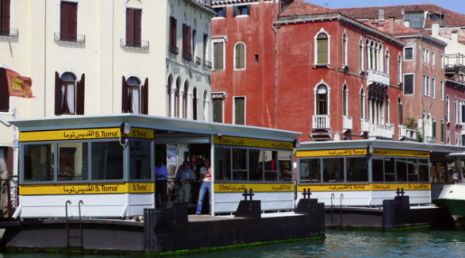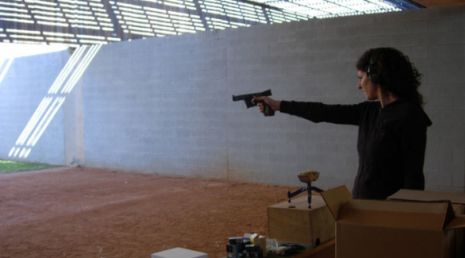Absence/Presence/Censorship
A public art work to be installed at the time of the Venice Biennale, Jacir translated the names of each vaporetto stop along the Grand Canal into Arabic and planned to place the translations next to the names in Italian, creating a bilingual transportation route signaling the cross-cultural exchange which had existed for centuries. She writes, "Addressing this rendered invisibility, my project aims to remind visitors and citizens of Venice, not only of its deep and varied cultural origins, exchanges and influences but also of possible futures of exchange."
"Isn't that part of the role of art? To produce a dialogue?"
"Absolutely that is the role of art!"
Creative Time Presents Emily Jacir, February 2010
stazione was abruptly cancelled by Venetian municipal authorities without explanation. No exchange took place.
"...my work was completely secular, addressing cultural exchange between Venice and the Arab world. I really don't think the fact that I am a Palestinian was the issue in Venice...I think it is more likely that the work was being presented in the public realm, in the streets of Venice, and not being confined to a designated 'art' space...I do believe that the Arabic script was a problem...When Arabic crawls out of...borders...and becomes part of the cityscape...perhaps this was the very thing that was so threatening to them."
We have a country of words. Speak Speak so we may know the end of/this travel.
From We Travel Like Other People by Mahmoud Darwish, translation: Abdullah Al-Udhari
Jacir's work, Translate Allah, uncovers a refusal, an aversion, an omission. She comments:
"Allah is simply the Arabic word for God. In America/Europe it has been misconstrued as a word used solely by Muslims to refer to God. In reality Arabic speakers of all faiths - Islam, Christianity and Judaism - use the word Allah for God. For example, millions of Arab Christians use Allah in their Bibles, hymns, poems, writings, and have been doing so for over nineteen centuries. Arab Jews and Arab Christians have been saying Allah for hundreds of years before Mohammed was born. The media's use of Allah rather than God is a deliberate move of course. By not translating Allah the media constructs an otherness in order to make it seem like 'their' God is different then 'our' God. It makes it easier to demonize and sound like some barbaric pagan entity; as well as negate it out of its historical and theological ties to Christianity and Judaism."
"Whatever is unnamed, undepicted in images, whatever is omitted from biography, censored in collections of letters, whatever is misnamed as something else, made difficult to come by, whatever is buried in the memory by the collapse of meaning under inadequate or lying language, this will become, not merely unspoken, but unspeakable."
Adrienne Rich, The Transformation of Silence into Language and Action
Memorial to 418 Palestinian Villages which were Destroyed, Depopulated and Occupied by Israel in 1948 was a 3 month community based project in which Jacir erected a refugee tent in her studio. Over 140 people came through her studio to sew the names of the disappeared villages while telling stories, recounting how each village was destroyed, socializing; often there was live Arabic music. There were lawyers, bankers, filmmakers, dentists, consultants, playwrights, artists, human rights activists, teachers, etc. There were Palestinians (some of whom come from these villages), Israelis (who grew up on the remains of these villages) and people from a multitude of countries. What remains is a document of those 3 months.
In a conversation with Jacir, Nato Thompson said "In 2002, your work was at the center of a controversy at the Queens International. There were two installations on display, with the first being Memorial to 418 Palestinian Villages Were Destroyed, Depopulated and Occupied by Israel in 1948 (2001), consisting of a refugee tent embroidered with the names of the 418 villages that had been decimated as a result of the 1948 war. The second piece you presented was about the 1964 World's Fair, whose grounds are right there. Accompanying this installation was a publicly available reproduction of a pamphlet from the 1964 Jordanian Pavilion at the World's Fair, which included a poem about the Palestinians exiled in 1948. The Queens Museum's Director, Tom Finkelpearl, began to receive calls complaining about the "anti-Israeli" sentiment in the pamphlet, a reaction that generally accompanies most Palestinian art in exhibitions, and the press jumped on it. In response to the pressure, the pamphlet was displayed under glass and not made publicly distributable."
Jacir responded: "...I reprinted the brochure exactly as it was distributed in 1964, and it was supposed to be passed out during this exhibition. My idea was that people would have this brochure in their hands...decades later...Once again, 38 years later, there was a controversy. After several people contacted the director of the museum, I was asked to cease distribution, but I would be allowed to have the brochures on display in a Plexiglas box. This turned the brochures into an inactive, dead object, which was not my intention and so, for me, the work ceased. [I was allowed to] distribute the brochure on the day of the opening only as long as I personally passed them out and they had a sticker on them that stated, "I reprinted this brochure as my artwork. Emily Jacir."
From Prison by Mahmoud Darwish
In the making of Material for a Film, a multi-media installation, whose subject is Wael Zuaiter, a Palestinian intellectual and artist murdered by the Mossad in Rome, Jacir collected thousands of pictures, documents, and sounds, and over three years conducted interviews with people who were part of his life. She reimagined his last moments, she listened to music he loved, she photographed the books that had been in his library. The work, an attempt to find Zuaiter in the traces he left behind, is designed so that viewers would move through the space as if entering a film, at their own pace.
"I got Janet Venn Brown's book, For a Palestinian: A Memorial to Wael Zuaiter, which is a collection of contributions by people who were part of Wael Zuaiter's life. It has a chapter by Italian filmmakers Elio Petri and Ugo Pirro entitled Material for a film, comprised of interviews with people who knew Wael. I wanted actual material for a film - the colors, the streets, the places and spaces that were a part of his life, sound recordings, feelings. Where was his apartment? What did it look like? What streets did he walk on? None of his stuff is in that chapter. I went back to Rome several times over a period of three years to continue the work of Janet, Petri and Pirro and I started gathering my own material for a film."
"Wael Zuaiter lived here. Where had the Mossad agents been hiding? It was around 10:30 p.m. when he headed to the stairwell of entrance C to take the elevator up to his flat. He reached the elevator. He was shot 12 times with a .22 calibre pistol with a silencer at close range. After spending several hours inside his building examining his floor, the courtyard and elevator, I leave."
"When Wael was living in Italy he used to sometimes be an extra in films in order to have some money. During my research I discovered that Wael Zuaiter had a role as a waiter when he was an extra in Peter Seller's film The Pink Panther, filmed in Rome at Cinecittà Studios, 1963. According to Janet he was so charismatic that the director picked him out of the crowd and offered him a speaking part but each time he got in front of the camera and they said; 'Ready! Shoot!' he froze and forgot all his lines. After Janet described his role to me, I managed to find 3 glimpses of him in the film. Janet told me she was quite disappointed when the film came out, as she sat through it twice only to see that he was a quick flash across the screen."
"On one of my first visits with Janet (who was Wael's companion for eight years), she told me that when he was murdered, he was carrying a copy of the book in his pocket [One Thousand and One Nights, which he was translating from the Arabic to Italian] and one of the bullets had hit the book. That is such a profound thing. I was so struck by that. I didn't sleep for days. I stayed awake working in my sketchbook."
These ideas translated into the Sydney piece. "I repeated the action of shooting the book as a performance. In A Thousand and One Nights, Scheherazade is constantly telling stories to survive."
"It is a memorial to untold stories. To that which has not been translated. To stories that will never be written. To the refusal to perform tragic stories for people to read. The one bullet hole of Wael's story serves as an entrance into all the other stories."
"The Sydney piece was a performance based on one element I discovered during my research which inspired an entire piece in and of itself. The Venice installation is an entirely different piece, although both draw from the same research. Venice is an attempt to present a film as an installation, or a documentary about Wael in an installation format...It is my journey of finding Wael in the traces he left behind...the process of my research re-enacts that of Petro and Pirro's, and, ultimately, that of Wael himself." [FN: Art Asia Pacific Interview jy/aug2007]
I want all our histories and narratives; every name, every village, every story, every account, every version, every attempt, every artifact, every battle, everything. All of it. No matter where it took place.
From: "Some things I probably should not say and some things I should have said (fragments of a diary)" in Palestine - Rien Ne Nous Manque Ici, ed. A. Laidi-Hanieh, Cercle d'Art, Paris, 2008.
To produce a dialogue?""
""Absolutely that is the role of art!""
And a new star
Has riveted itself upon my eye.""







